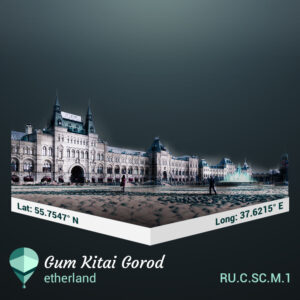 Built from 1890 to 1893, the GUM Kitai-Gorod is certainly the most imposing of all GUM department stores. Standing for “Main Universal Store” in Russian, the GUMs were established during the Soviet Union in an attempt to democratize food consumption for the low-classes nationwide. This 242 meters long building was initially ordered by the “Red Square Society of the Superior Galleries”, a gathering of merchants willing to house all of their boutiques in the same building.
Built from 1890 to 1893, the GUM Kitai-Gorod is certainly the most imposing of all GUM department stores. Standing for “Main Universal Store” in Russian, the GUMs were established during the Soviet Union in an attempt to democratize food consumption for the low-classes nationwide. This 242 meters long building was initially ordered by the “Red Square Society of the Superior Galleries”, a gathering of merchants willing to house all of their boutiques in the same building.
GUM is one of the most famous shopping centers in Russia but in all post-Soviet countries. The building erected in the pseudo-Russian style became a symbol of Russia, as did the Cathedral of St. Basil or the Kremlin.
The Upper Trading Rows, the future GUM, were opened in 1893 with a canal: the stall owners that had previously stood in its place resisted construction for twenty years. The new "passage" with facades in the patriotic neo-Russian style and glass vaults quickly became a favorite among Muscovites. Here they walked, shopped (in 322 sections), and listened to concerts.
The Upper Trading Rows were closed in 1918, and offices were opened in the building. In 1921, a store called the "Main Department Store" was reopened. The first GUM worked for ten years. In 1931, offices were located here again, and apartments on the second and third floor. After Stalin died in 1953, GUM was finally opened. People who stood in lines in front of the best department store of their time were jokingly called humanists (play on words: gum - gumanist / humanist). In the late 90's GUM was renovated.
Mayakovski made the first advertisement for GUM, and it read as follows: "Everything that the body, stomach, and mind need / Everything will be provided to a person by GUM". From GUM, Levitan conveyed the good news of the victory on May 9, 1945.
GUM is known not only for its stores but also for its fountain, which is the embodiment of an architectural genius. Next to which thousands of romantic meetings and business meetings were scheduled. The fountain in the central part of GUM is a historical monument, erected in 1906. First, the cup of the fountain was round and made in the shape of a dome. It acquired its current octagonal shape in 1958, during reconstruction. In the center of GUM, guests who are next to the fountain see the water "playing". The jets of the fountain seem to perform choreographic points. And every half hour, the central jet bursts more than 20 meters in height.
The construction of the Upper Trading Rows, which began during the reign of Emperor Alexander III, meant that people would come here to buy and rest and have fun to spend a lot of time there. That is why a toilet and an autonomous sewer were planned in the building during the design phase.
The historic toilet had two exits: separate for men and women. Finnish granite and marble were used for the interior. Bidets and toilet bowls made of faience, brought from England, were placed in the toilet cubicles. On the tables were powders and perfume on the "female half", cologne water in the "male part". The historic toilet in GUM was closed for renovations in 2004 that lasted for almost 7 years. The interior of this popular center is constantly changing.
The Russians try to make the GUM attractive and interesting since it is one of Russia's most famous shopping centers and beyond, and it looks best during the holidays. Today, many years after the October Revolution and Stalin's reign, GUM remains a truly magnificent 2 million square feet building and a great opportunity to buy high-class products in over 1,000 shops.